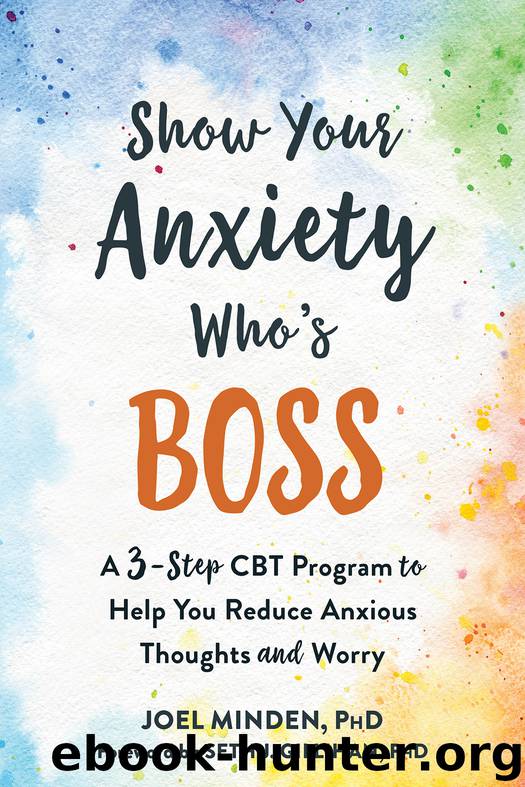Show Your Anxiety Who's Boss by Joel Minden

Author:Joel Minden
Language: eng
Format: epub
Tags: anxiety;panic attack;worry;social anxiety;control;CBT;cognitive behavior therapy;process-based CBT;uncertainty;intrusive thoughts;catastrophic thinking;triggers;social situations;fear;phobias;relationship conflict;sleep trouble;avoidance;passivity;procrastination;low motivation;runaway thoughts;exposure therapy;distress tolerance;acceptance;self compassion;losing control;suffering
Publisher: New Harbinger Publications
Published: 2020-01-27T20:07:24+00:00
Three Ways of Avoiding
Earlier, I asked you to write down the ways in which avoidance creates problems in your own life. Most of us have some anxiety-reduction strategies that stand out because we use them intentionally and often, and perhaps you thought of those right away. But avoidance can be subtle and hard to notice, to the point that we don’t always recognize some of the little things we do to cope. As you go through the descriptions of the three types of avoidance, see if you can identify personal patterns of avoidance you haven’t considered before and the roles they play in your life.
Cognitive Avoidance
It’s common to understand avoidance as a behavioral pattern of distancing ourselves from certain activities or situations. Relatable examples for many include avoiding chores, work projects, or confrontation. But avoidance can be a cognitive process, too. If it’s uncomfortable to worry, for example, we try to protect ourselves by redirecting attention to something else. At best, this avoidant tactic provides a bit of short-lived relief; at worst, it shows us that we’re ill-equipped to work through our thoughts and destined to suffer with anxiety.
For some, the problem of cognitive avoidance can be understood as a response to anxious fictions that are unclear and generalized. Thoughts like “It’ll be terrible” or “I’ll be so embarrassed” are vaguely unpleasant, so it’s no wonder we try to cope by focusing on other things. Ambiguous ideas like these create two problems. First, they’re difficult to tolerate, because they suggest the problems we’re about to face are numerous and collectively overwhelming. Second, they prevent us from thinking objectively about our experiences. Think about it: How can we possibly evaluate whether “it” was “terrible” or if we felt “so embarrassed” if we don’t allow ourselves to clarify these ideas?
Although generalized concerns contribute to avoidance for some, others become overwhelmed when they consider a troubling, highly specific aspect of an upcoming event. They latch on to one idea and find it difficult to let go. Whether it’s the magnitude of the problem, an obstacle to success, or the consequence of a setback, the perceived importance of that detail leads at first to fixation and then to avoidance.
Download
This site does not store any files on its server. We only index and link to content provided by other sites. Please contact the content providers to delete copyright contents if any and email us, we'll remove relevant links or contents immediately.
Should I Stay or Should I Go? by Ramani Durvasula(7621)
Why We Sleep: Unlocking the Power of Sleep and Dreams by Matthew Walker(6651)
Fear by Osho(4696)
Flow by Mihaly Csikszentmihalyi(4656)
Rising Strong by Brene Brown(4411)
Why We Sleep by Matthew Walker(4394)
The Hacking of the American Mind by Robert H. Lustig(4336)
How to Change Your Mind by Michael Pollan(4313)
Too Much and Not the Mood by Durga Chew-Bose(4301)
Lost Connections by Johann Hari(4134)
He's Just Not That Into You by Greg Behrendt & Liz Tuccillo(3856)
Evolve Your Brain by Joe Dispenza(3631)
The Courage to Be Disliked by Ichiro Kishimi & Fumitake Koga(3435)
Crazy Is My Superpower by A.J. Mendez Brooks(3358)
In Cold Blood by Truman Capote(3343)
Resisting Happiness by Matthew Kelly(3322)
What If This Were Enough? by Heather Havrilesky(3286)
The Book of Human Emotions by Tiffany Watt Smith(3265)
Descartes' Error by Antonio Damasio(3247)
